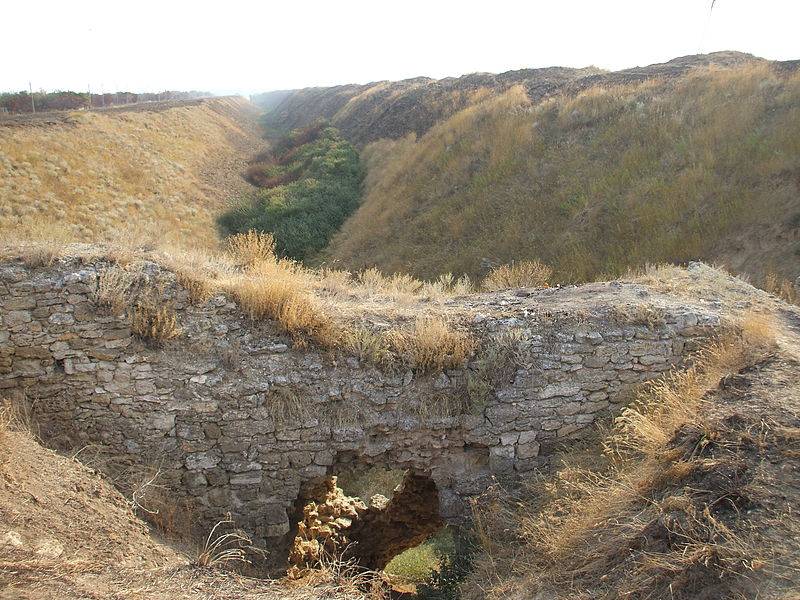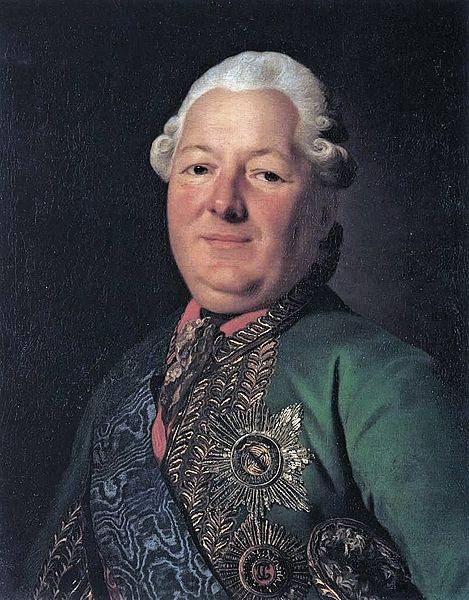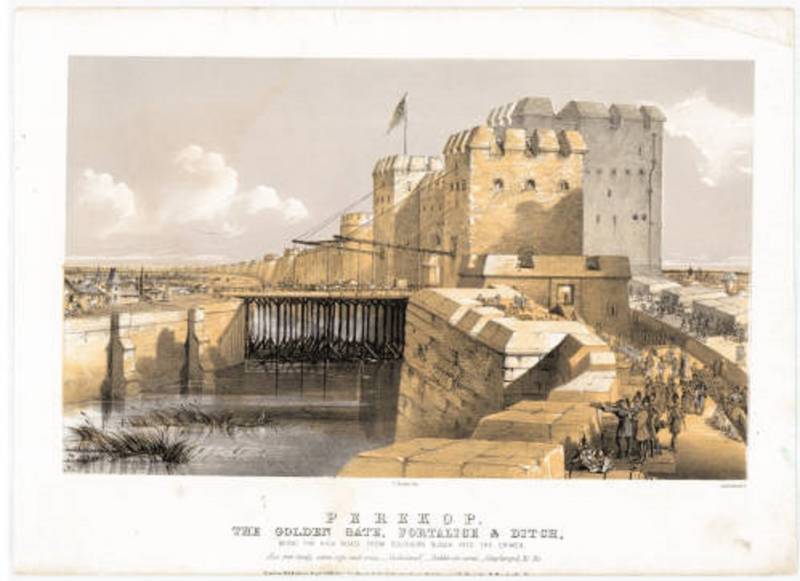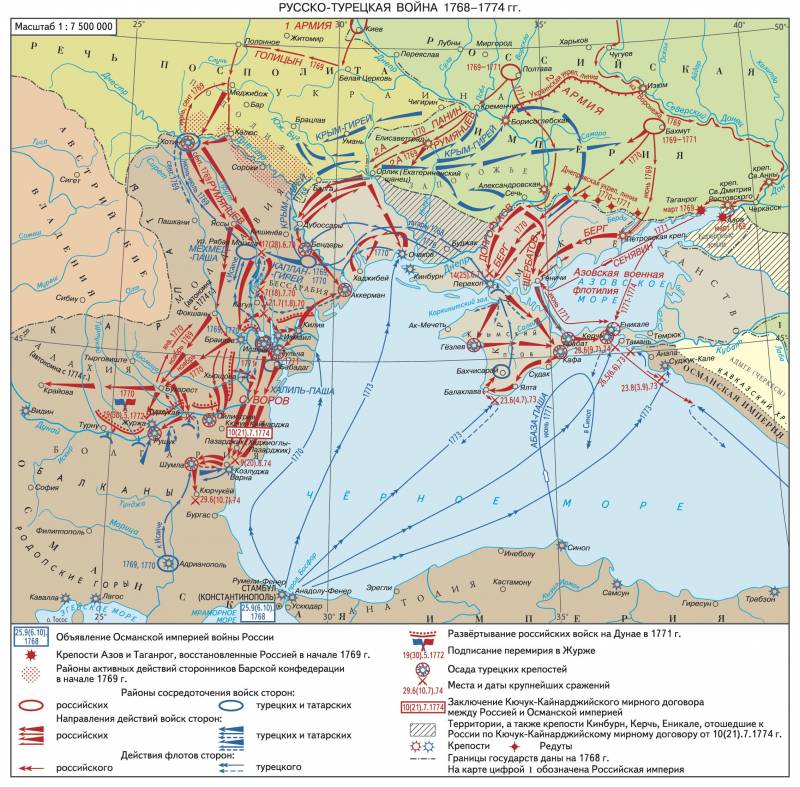How Dolgorukov stormed the Perekop line
General situation
During the Russian-Turkish war that began in 1768, our armies operated in two main directions - the Danube and the southern (Crimean). In 1770, under the influence of the military successes of Russia and the successful diplomacy of Count Peter Panin, the Nogai Tatars of the Budzhak, Edisan, Edichkul and Dzhambulak hordes decided to leave the Ottoman Empire and accept the patronage of Russia. This significantly weakened the Crimean Khanate.
In Crimea itself, there was no unity, there was a struggle for power. Among the nobility there was a strong party that did not want war with Russia and wanted to free itself from vassal dependence on Turkey with its help. In 1769, during the hostilities, Khan Kyrym-Girey suddenly died (possibly, he was poisoned). The new khan Devlet-Girey tried to organize the Crimean horde to fight with Russia, but his opponents thwarted a new mobilization. In 1770, Constantinople deprived Devlet of the throne. Another Khan Kaplan-Girey fought at the Danube Theater, was defeated at Larga, and after a number of other setbacks returned to Crimea. Under the influence of the pro-Russian party, which wanted to end the war and free itself from the power of the Port, Kaplan began negotiations with Russia. He was removed from office and summoned to Turkey, where he soon died. The new khan was Selim-Girey, an opponent of rapprochement with Russia.
In the meantime, Petersburg decided to complete the business of creating Novorossiya and occupy the Crimea. The annexation of Crimea crowned a long process of struggle between the Russian state and the Crimean Khanate and Turkey. It is necessary to pacify the last large fragment of the Golden Horde - the Crimean Khanate, eliminate the robber, slave-owning state formation, the Turkish strategic bridgehead and the base that threatened southern Russia. To complete the economic development of the former "Wild Field". To create a full-fledged fleet in the Black Sea and turn it back into the "Russian". Crimea was the key territory that ensured the domination of the Russian Empire in the Northern Black Sea region. This was the solution to one of the age-old key political tasks of Russia.
Operation plan
The task of conquering the Crimea in the campaign of 1771 was entrusted to the 2nd Russian army under the command of the general-in-chief, Prince Vasily Mikhailovich Dolgorukov. He is known for the fact that during the campaign of 1736 he was the first to break into the Perekop fortifications and survived. Before the assault on Perekop, Field Marshal Munnich promised that the first soldier who ascended the fortifications alive would be promoted to officer. The first was the young Dolgorukov, who received the rank of lieutenant for this. Earlier, the Dolgorukov family fell into disgrace, and Tsarina Anna Ioannovna ordered not to give any of the Dolgorukov ranks. Later, the prince was noted in a number of battles of the Seven Years War. In 1770 he replaced Panin as commander of the 2nd Army.
The Russian army (about 30 thousand regular troops and 7 thousand Cossacks) set out from Poltava on April 20, 1771 and moved south along the Dnieper. This time, the supply task, which was practically the main one in previous campaigns to the Crimea, was solved. The Dnieper and Don were used for supply. Stores (warehouses) on the Ukrainian fortified line and in the fortifications of the Elizavetgrad province were easily replenished. On the Dnieper, supplies were transported to the former Ottoman fortress Kyzy-Kermen, along the Don basin - to Taganrog, where the main store was, then from there the goods were transported by ships to the Petrovsky fortification on the river. Berde and other places. Azov, created during the war with Turkey flotilla under the command of Vice Admiral Senyavin in 1771, she gained combat capability and supported the offensive of the 2nd Army. The flotilla was supposed to cover the ground forces from the sea, where Turkish ships could appear, defend the points occupied in the Sea of Azov and bring supplies.
The conquest of the Crimea depended on the occupation of its main points. Therefore, it was necessary to capture the Perekop fortress, a ditch with a rampart, separating the Crimean peninsula from the mainland, and fortified by forts and the Or-Kapu fortress. Kerch and Yenikale, as fortresses, connecting the Azov and Black Seas. Kafa (Feodosia), Arabat and Kezlev (Evpatoria), as seaside points that ensure domination in the Crimea.
Therefore, the 2nd Army was divided into three groups, which had their own tasks. The main forces under the command of Dolgorukov were to occupy Perekop and go to Kafa. The detachment of Major General FF Shcherbatov was supposed to force the Sivash with the help of the Azov flotilla, take the Arabat fortress and then go to Kerch and Yenikale. Major General Brown's third detachment was to occupy Evpatoria.
Senyavin's flotilla was based at the mouth of the Berda, at the Peter's fortress. In the event of the appearance of Turkish ships in the Sea of Azov, the flotilla was supposed to stand at the Fedotova Spit and not let the enemy go to Genichesk. However, heavy Turkish ships, which had a deep landing, could not operate in the shallow waters of the Azov Sea coast. Also, the Russian flotilla could support the capture of Arabat, Kerch and Yenikale.
Also, part of Dolgorukov's army was left to defend the southern borders of the empire. Mostly light forces. They reinforced the garrison of the Elizabethan fortress, remained on the Ukrainian line, carried out patrol service between the Dnieper and the Sea of Azov. A special detachment of General Wasserman covered the area between the Dniester and the Bug, from the side of Ochakov. This unit also linked the 1st and 2nd armies.

Remains of the Perekop shafts
2 Army Offensive
Having crossed the Vorskla River, Dolgorukov decided to go to the Crimea in a big roundabout way in order to avoid movement in the desert area. The troops followed the course of the Dnieper, moving away from it for several miles. On the left side of the Dnieper, there were small rivers, which solved the problem of water supply. The vegetation along the Dnieper provided fuel and food for the horses. Insignificant tributaries of the Dnieper could be forded without any problems and only occasionally built gates for the passage of artillery. To avoid the intense heat, the troops marched at 2-3 o'clock in the morning.
On April 23, 1771, the 2nd Army entered the Orel River, stood here until May 5, waiting for the collection of all troops. On May 7, the troops were at the Samara fortification, at the confluence of the Samara River into the Dnieper. Dolgorukov stayed here until May 13, waiting for the construction of a bridge across Samara. At this time, the soldiers were preparing assault ladders and other devices for a future attack on the Perekop line. On May 18, the army was at the Alexander Redoubt at the confluence of the Moskovka River into the Dnieper. Having given two days to rest, on the 21st Dolgorukov continued the hike.
Forcing the Horse Waters River, where they made a bridge on piles for the artillery, and two pontoon bridges for the infantry and cavalry, the troops went to the small river Mayachka, where they joined up with the detachment of General Berg, who was going from Bakhmut.
On May 27, the army was divided: Shcherbatov's detachment followed in the direction of Arabat, the main forces continued to follow the course of the Dnieper. On June 5, the troops were opposite Kyzy-Kermen. From here the road from the left stream of the Dnieper turned sharply to Perekop. Therefore, a strong redoubt, Shagin-Gireysky, was built in this place for several days. The main food warehouse of the army was located here, from where supplies were supposed to bring mobile stores. Two infantry companies, 2 Cossacks, several squadrons of carabinieri and cannons were left to guard him. A post of the same strength was set up in the direction of Kinburn.

Portrait of V.M.Dolgorukov-Crimean by Alexander Roslin (1776)
Storm Perekopa
On June 12, 1771, Dolgorukov's troops reached Perekop. The enemy cavalry set out from the fortress, the Cossacks and light troops started a firefight with the enemy. After that, the Tatars and Turks did not dare to set out in the field. The Perekop line stretched from the Black Sea (Perekop Bay) to the Sivash for about 7,5 km. The part of the line that adjoined the Sivash was severely destroyed by water. The strongest fortification protecting the road leading to the Crimea was the Perekop fortress (Or-Kapi). The fortress had a five-pointed shape with earthen walls lined with strong stones and quadrangular towers.
In the Perekop area there was a Crimean Turkish army led by Khan Selim-Giray III - 50 thousand Crimeans and 7 thousand Turks. At the same time, the Sultan's government planned to send an army to the Northern Black Sea region. However, threats from other directions forced Constantinople to abandon these plans. The Russian fleet (First Archipelago Expedition) destroyed the Turkish Navy in the Mediterranean and threatened the Dardanelles. Also, supplies of provisions by sea to the Turkish capital were interrupted, which caused the threat of a riot. The Sultan was forced to keep large forces in Constantinople and hastily strengthen the Dardanelles. The successes of the Russian and Georgian troops in the Caucasus forced the Porto to send additional forces to the Georgian front. As a result, the sultan was unable to send the forces necessary for the defense of the peninsula to the Crimea.
Having examined the fortress, Dolgorukov decided to take it on the move, without a long siege. The Russian command decided to bypass the strongest place of the enemy - the fortress. The main blow was delivered along the line that adjoined the Black Sea. Part of the cavalry and infantry planned to wade across the Sivash, bypassing the enemy's right flank. On the section of the rampart near Sivash, they decided to conduct a false attack. In addition, detachments of infantry and cavalry with cannons were deployed in areas where there were gates on the line to prevent the Crimeans from conducting sorties during the main assault.
On the night of June 13-14, a small detachment of infantry under the command of General Kakhovsky began shelling the fortified line near Sivash, diverting attention to themselves. The enemy knew that here he had the weakest point and concentrated his main forces here.
Meanwhile, the main assault column (9 battalions of grenadiers and 2 battalions of rangers), under the command of General Musin-Pushkin, secretly went to the rampart. The soldiers descended the stairs into the moat and climbed the rampart. As a result, our troops with a swift attack captured the fortifications from the Black Sea to the fortress.
At this time, the cavalry of General Prozorovsky crossed the Sivash, went to the rear of the Crimeans. The Tatars tried to counterattack with their entire mass of cavalry. Our cavalry withstood the attack, at which time the infantry approached. The Crimeans quickly lost heart and fled. Our cavalry pursued them deep into the peninsula for 30 miles. The Perekop line near Sivash was also captured.
The garrison of the Perekop fortress (over 800 soldiers) surrendered on June 15 after an artillery bombardment.
Over 170 cannons were captured in the fortress and on the rampart.
The losses of the Ottomans and Tatars amounted to more than 1200 people, the losses of the Russian troops - more than 160 people.
Thus, the Russian army opened its way to the Crimea.
The Crimean army fled to Kafa.
Having set up a rear base in Perekop, on June 17, Dolgorukov's army moved to Kafa. A detachment of General Brown (about 2,5 thousand people) went to Kezlev (Evpatoria).
To be continued ...


Information